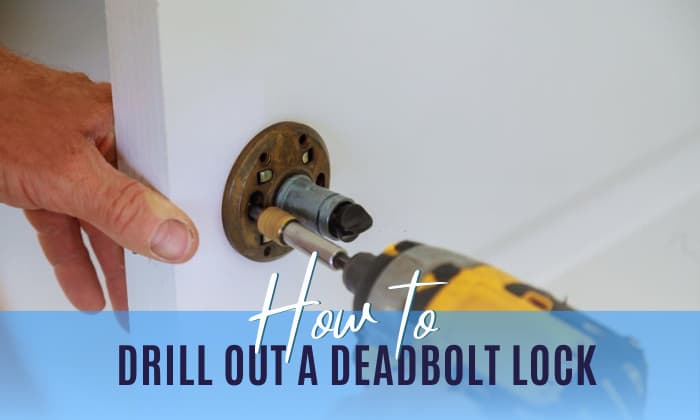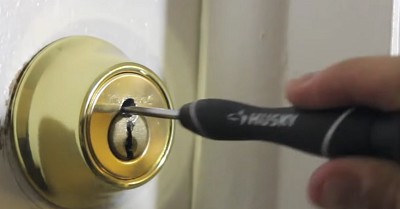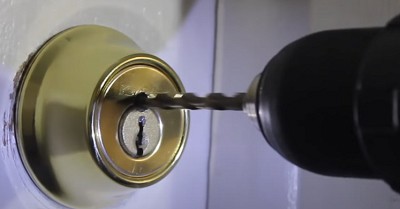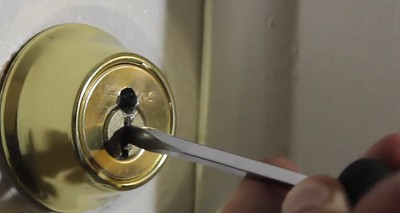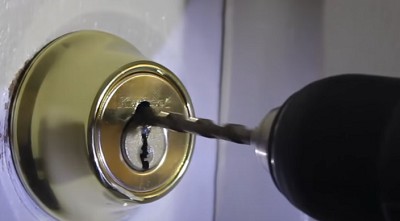Having a deadbolt lock like the Kwikset deadbolt installed provides security against break-ins and physical forces. Unlike other locks, which are susceptible to knives and crowbars, deadbolts are known to be invulnerable to these door-picking mechanisms.
However, losing your key to your deadbolt commercial lock or having your deadbolt rusty enough that it won’t budge might spell misery for you.
Fortunately, there is a one-trick pony to open deadbolt without key that you can always rely on when you don’t have any other choice.
In this article, I will show you how to drill out a deadbolt lock.
Table of Contents
Step-by-step to Drill Out a Deadbolt Lock
If you really want to access the things behind your door and you do not mind having your deadbolt lock damaged, your best bet is going for the process of drilling out a deadbolt lock.
This ensures a clean and hassle-free process compared to other methods to break a deadbolt from the outside.
To break into a deadbolt lock with a drill, follow these steps:
Step 1: Prepare the following materials:
- Power drill
- ¼ and ⅛ inch drill bits
- Hammer
- Punch
- Screwdriver
- Lubricant
Step 2: Wear your safety equipment.
When drilling out a lock cylinder, some residue might fly off and hit you so make sure you wear gloves and goggles.
Step 3: Make a guidance point.
Take your punch and position it directly above the keyhole, as this is the point where the pins of the lock can be located. Hammer your punch so that it will leave a guidance point where you will be drilling.
Note: make the guidance point shallow enough so that you will prevent having your drill veer off while drilling out a Schlage deadbolt.
Step 4: Drill the guidance point.
With your ⅛ inch drill bit, start drilling on the guidance point and keep the drill level in the process.
This step will destroy most of the pins inside the lock, thus you will feel a bit of resistance. If the drill becomes stuck in the middle, one solution is to reverse the drill while pulling it out, allowing all of the broken metal filings to escape.
If you cannot proceed deeper into the lock, take out your drill and put some lubricant.
Step 5: Check for progress.
With a screwdriver, check the keyway if it can be opened manually by turning it clockwise and counterclockwise. If the lock doesn’t budge or fall off, you might take it to the next step.
Step 6: Drill with a larger drill bit.
Take your ¼ inch drill bit and attach it unto your drill. Since some pins inside the lock are still not taken out by the smaller drill bit, you will have to drill the lock again.
Step 7: Check for progress again.
Sometimes, the lock might fall off on its own. However, if that is not the case, you can always use your screwdriver to manually turn the keyway to pry the lock out of the door.
Note: if the lock still doesn’t budge, drill out the bolts of the lock. They are usually located on both sides of the keyway.
FAQs
What kind of drill do I need to drill out a lock?
In order for you to achieve the quickest and best result possible when you open a deadbolt lock with a drill, you have to use a variable-speed power drill.
This will help you change speed depending on how deep your drill goes to avoid damaging the parts of the door.
What size drill bit do you use to drill out a deadbolt?
The sizes of drill bits for drilling out locks are commonly ⅛ inch drill bit and ¼ inch drill bit. The ⅛ inch drill bit is used to create a starting space for the bigger drill bit, while the ¼ inch drill bit is used to drill out the pins to unlock the deadbolt lock.
Additionally, it is worth noting that the drill bits you will use to drill through a lock should either be made of carbide or cobalt. This will ensure that your drill bit will not be easily damaged in the drilling process.
If you want or have to eliminate the lock cylinder since drilling the pins is not enough, you might need a ¾-inch bit.
Conclusion
It pays learning basic handiness skills and becoming a reliable person. It will not only help you become handy, but it will also save you lots of time and money from hiring a locksmith or a professional.
Maintaining the security inside your home is a must, especially when you have a family and valuables to protect. Knowing how to drill out a deadbolt lock will go a long way.

I am the last member to join Revolar and might be just the luckiest to work with dedicated people like Teddy and John. Our team has established a process where my only job is writing the best content to deliver incredible ideas and guides.


